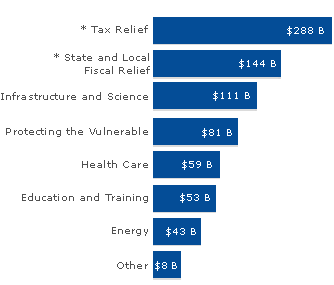
The 2009 Stimulus Package or 'American Recovery and Reinvestment Bill of 2009' has passed and is one of the most expensive government expenditures in all of human history. At $787 billion it will be 3% of US gross domestic product over the next two years.
Timline For the 2009 Stimulus Package
Feb 17th -- President Obama signed the 2009 stimulus package in Denver, Colorado as expected. "The American Recovery and Reinvestment Act that I will sign today, a plan that meets the principles I laid out in January, is the most sweeping economic recovery package in our history." -- President Obama.
Feb 16th -- President Obama will sign the 2009 Stimulus Bill in Denver tomorrow, Tuesday February 17, at the Denver Museum of Nature & Science; "I will sign this legislation into law shortly, and we'll begin making the immediate investments necessary to put people back to work" - President Obama
Feb 13th -- The Senate just passed the $787 billion economic stimulus bill supported by President Obama by a 60-38 vote. As predicted only Republican senators Susan Collins and Olympia Snowe of Maine and Arlen Specter of Pennsylvania broke GOP ranks and supported the bill. President Obama is expected to sign the legislation into law early next week.
Feb 12th -- The House and Senate have reached a compromise on the stimulus bill. The final bill comes in at a lower price tag than either the original House or Senate bill. The, almost final, $789 billion stimulus package will be divided roughly between 35% tax cuts and 65% new government spending. Half of the new spending will be for infrastructure like roads, highways and renewable energy. The other half of the spending will be given to states to stabilize their economies and prevent further job loss.
Feb 11th -- The final stimulus bill continues to be debated with Republican senators Susan Collins and Olympia Snowe of Maine and Arlen Specter of Pennsylvania controlling the direction of the negotiations. If these Republicans withdraw their support the bill will not pass, and the White House and the Democrats will be forced back to the drawing boards. This gives these three Senators enormous power in the discussions. We can therefore expect the final bill to have significant amounts of spending removed, probably the money for school construction and health care.
Feb 10th -- The Senate passed the $838 billion package by a vote of 61 to 37. The House and Senate bills will now go to conference committee and then a single bill will be sent to President Obama to be signed into law.
Feb 9th -- 50 million people tuned in tonight to watch President Obama in his first news conference. He strongly urged Congress to pass the stimulus bill and defended deficit spending as crucial to jump start the economy and prevent more job loss and foreclosure.
Feb 8th -- Republican senators Susan Collins and Olympia Snowe of Maine and Arlen Specter of Pennsylvania have shifted the votes to Obama's favor for the stimulus package. The Democrats in the Senate now have enough votes to stop any GOP filibuster and so the stimulus package (currently written as $827 billion) will likely pass the Senate today.
Feb 7th -- To increase the political pressure on Congress to pass the stimulus plan and highlight the economic crisis, President Obama will be visiting Elkhart, Indiana and Fort Myers, Florida in the next few days. Both cities have an extremely high unemployment rate; Elkhart's unemployment is at 15.3% and Fort Myers unemployment is at 10%. (Labor Department data, released yesterday, showed the national unemployment rate at 7.6%).
Feb 6th -- The US Senate has reportedly come to a tentative compromise deal on the stimulus package, which has been losing public support over the past few days. The deal would include cutting some of the wasteful spending to placate resisting Republicans and move this to a floor vote soon.
The tentative deal is reported to be $780 billion ($805 billion according to some sources) - this is down from the $937 billion price tag just two days ago. The house previously passed a bill of $819 billion without any Republican support and even without some Democrats supporting the bill. Once the House and Senate have both passed bills they will work out the differences and send the final bill to the President's desk.
President Obama ratcheted up the rhetoric and is strongly campaigning for the bill's passage and insists that it needs to be passed quickly so that he can sign it into law by next Friday.
Those Complicated Terms
Don't get confused by the many new unfamiliar economic terms being used in the media. ‘Fiscal stimulus' is an economic term that refers a tax cut or an increase in government spending to support or revive an economy. The goal is to increase consumption, investment, government purchases, and net exports (otherwise called ‘aggregate demand' by economists)
Basically the idea is that if the government gives people (and businesses) money, they will use it to buy more goods and services. They will keep the demand for those goods and services high and the companies providing the goods and services will not lay people off.
For example if a family has more money they might be able to afford to finish their basement. This keeps the demand for plumbers high and the plumbing company doesn't need to lay off their newest plumber. The plumber now has more money (because he/she didn't get laid off) and they can afford to take their family to the movies on the weekend. This keeps the demand in the entertainment industry high and the movie theater does not need to lay off their newest cashier. The cashier (because he/she didn't get laid off) now has money to buy an occasional Happy Meal for their child at McDonalds. This keeps the demand for McDonalds high and McDonalds doesn't need to lay off their newest drive through worker...etc etc.
The idea is that if you stimulate the economy enough in this manner, the plumbing company, restaurant, etc will not only be able to avoid laying off employees but that the demand for their goods/services will be so high that they will actually hire new employees.
This is part of President Obama's plan; he hopes that his 2009 Stimulus Package is so large that it will prevent further layoffs and actually create "3 -4 million new jobs"
Why Haven't I Heard of Stimulus Packages Before?
You probably don't remember any ‘Stimulus Packages' in recent decades because they have not been used widely as a means to encourage economic growth. Since the Depression economists have generally agreed that fiscal policy (fiscal stimulus packages) was not a good way to improve the economy, even during a recession. It was commonly believed that controlling the amount of money available in an economy could have the same impact on demand as direct fiscal stimulus. The amount of money available in an economy can usually be controlled by adjusting interest rates.

In the US economy, the Federal Reserve has been adjusting interest rates for decades and tweaking the demand for goods and services simply by adjusting how easy and inexpensive it was to get credit. For example, if the housing market was slumping the Federal Reserve could lower interest rates and then banks could offer lower interest rates on mortgages.
Lower mortgages would entice/enable more people to buy houses and the demand for houses would go up. Then like our fiscal example above, the high demand for houses would then keep the demand for plumbers high and the plumbing company doesn't need to lay off their newest plumber. The plumber now has more money (because he/she didn't get laid off) and they can afford to take their family to the movies on the weekend. This keeps the demand in the entertainment industry high and the movie theater does not need to lay off their newest cashier. The cashier (because he/she didn't get laid off) now has money to buy an occasional Happy Meal for their child at McDonalds. This keeps the demand for McDonalds high and McDonalds doesn't need to lay off their newest drive through worker...etc etc.
Times Have Changed
Interest rate tweaking can lose its desired effect in certain economic conditions. If people are getting laid off, they can't buy houses no matter what the interest rate on their mortgage is going to be. Even people with jobs might stop spending so freely when their confidence in the economy is low. Small business owners might think twice about hiring new people and the problem snowballs. Also, in our current economy we have the added dilemma of the banks refusing to loan money even if they are getting great interest rates from the Federal Reserve. The banks are so gun-shy about incurring bad debt that obtaining new credit is much more difficult despite the low interest rates.
In February 2008 President Bush and congress approved a $168 billion package of tax cuts and rebates. If you filed a tax return in 2007 you probably got a rebate check as part of this Feb 2008 Stimulus Package. You probably used it to pay credit card bills, buy a plasma TV, or otherwise pay for something; you probably didn't put the money in a savings account. Your spending was exactly what Congress hoped for and the economy was mildly stimulated (many people DID put their 2008 rebate check into savings which is good for personal finances but not as good for the economy in the short run).
Unfortunately in the fall of 2008 Wall Street imploded and there was a dramatic economic slow down. President Bush and Congress struggled to stave off financial catastrophe and approved a $700 billion 'bailout' package called the Troubled Asset Relief Program (TARP). It was not really a stimulus package as it was not so much to stimulate business as to prevent its collapse; it was intended to buy bad debt,'bailout' financial institutions, etc.
Companies that accepted TARP funds in 2008 are excluded from many of the 2009 stimulus package programs. This has cause much debate in Congress.
The Stimulus Package is $787 Billion - Where will the Money Go?

* Tax Relief - includes $15 B for Infrastructure and Science, $61 B for Protecting the Vulnerable, $25 B for Education and Training and $22 B for Energy, so total funds are $126 B for Infrastructure and Science, $142 B for Protecting the Vulnerable, $78 B for Education and Training, and $65 B for Energy.
Read the full and final text of the 2009 Stimulus legislation (PDF, 13.4MB).
The goal is for the Package to accomplish the following:
- Create or save more than 3.5 million jobs over the next two years;
- Take a big step toward computerizing Americans' health records, reducing medical errors, and saving billions in health care costs;
- Revive the renewable energy industry and provide the capital over the next three years to eventually double domestic renewable energy capacity;
- Undertake the largest weatherization program in history by modernizing 75 percent of federal building space and more than one million homes;
- Increase college affordability for seven million students by funding the shortfall in Pell Grants, increasing the maximum award level by $500, and providing a new higher education tax cut to nearly four million students;
- As part of the $150 billion investment in new infrastructure, enact the largest increase in funding of our nation's roads, bridges, and mass transit systems since the creation of the national highway system in the 1950s;
- Provide an $800 Making Work Pay tax credit for 129 million working households, and cut taxes for the families of millions of children through an expansion of the Child Tax Credit;
- Require unprecedented levels of transparency, oversight, and accountability.
The Debate
There was vast disagreement between Democrats and Republicans and the House Stimulus Bill passed without a single Republican Representative voting in favor of it (several Democrats voted against it as well).

The debate was over relative minutia. There was no serious opposition to a stimulus package of some kind, there was simply debate about what it contains. When you talk in terms of hundreds of billions of dollars it is easy for congressmen's pet projects, costing tens of millions of dollars, to be added without much notice. Also, lobbyists worked hard to tailor the bill for their specific interests. For example GE spent enormous amounts of money lobbying for "green" provisions favorable to them. GE was successful; much of what GE wanted is now part of the Bill. GE convinced congressmen to add tens of billions in funding for an electrical grid for which GE happens to make the parts. Also, several other environmentally friendly provisions helpful to GE were added. This, of course, angered some of the smaller "green" companies that were hoping for some of the money. Others argue that the bill was supposed to stimulate the economy and not feed pet political projects, etc and so the Washington bickering continued despite the general agreement that a stimulas is needed.
Related Articles
- Lost Your Job?
- The 2009 Omnibus Bill Explained
- What Are Earmarks?
- Obama's Loan Modification Plan Explained
- Stimulus Plan 2009-What's In it For You
- What is a Reverse Mortgage?
- Loan Modification: Is it Right for You?
- Obama Stimulus Plan FAQ
- 2009 Economic Stimulus Plans-A Glossary of Terms
- Executive Summary of the 2009 Economic Stimulus Plan
- $8,000 Tax Credit for First Time Homebuyers
- Saving and Managing Your Money During a Recession
- First Time Homebuyers Guide
- Financial Assistance for First Time Homebuyers
- How to Improve Your Credit Score
- 5 Tips For Improving Your Credit Score
- How to Avoid Foreclosure
- What Is Foreclosure?
- What Is A Short Sale?
- What Is A Deed-In-Lieu?
- Avoiding Foreclosure Rescue Scams
- How to Buy a HUD Home
- Tips on Buying a Home
- How to Sell Your Home In a Down Market
- Do You Qualify for an FHA Loan?
 Print
Print Email
Email







